#albertosaurus sarcophagus
Text


Happy Fossil Friday!
Who: Albertosaurus sarcophagus ("Alberta-Lizard" "flesh-eater")
What: A large tyrannosaur from the Theropoda clade.
When: Late Cretaceous
Where: Horseshoe Canyon Formation in Alberta, Canada
Fun Fact!: Albertosaurus was first discovered on the Red Deer River in Drumheller, Alberta in 1884 by geologist Joseph Tyrrell, for whom the world famous museum in Drumheller is named. Tyrrell's specimen remained unnamed until 1905 until the discovery of Tyrannosaurs rex in Colorado. This coincided with the province of Alberta being founded on September 1st in 1905 and Albertosaurus shares its namesake.
Why are they cool?: Evidence suggests that these large, predatory dinosaurs lived together in family groups and hunted in packs, rather than in solitary. The same may be true for other theropods.
Here is a link to a paper discussing the ages and assemblage of the Dry Island Bonebed in Drumheller, where a whopping 26 Albertosaurus were discovered!
Image Credits: (Left and Right) www.thoughtco.com - fun fact! both these images were taken at the Royal Tyrrell Museum in Drumheller Alberta.
#palaeontology#paleontology#fossil friday#fossils#paleo#albertosaurus#albertosaurus sarcophagus#alberta#royal tyrrell museum#drumheller#tyrannosaur#horseshoe canyon
8 notes
·
View notes
Text

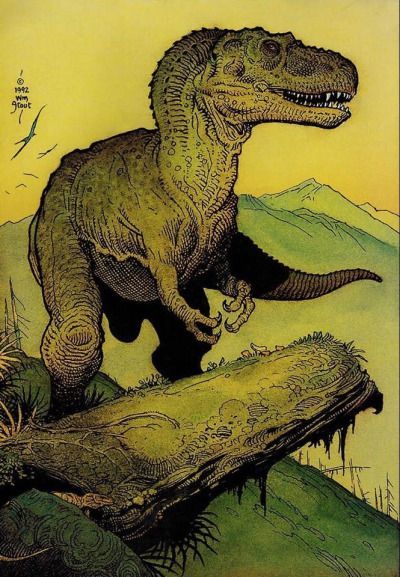
"AN ALBERTOSAURUS PICTURE I DID WAS A REAL BREAKTHROUGH FOR ME AS FAR AS HELPING ME TO UNDERSTAND DINOSAUR POSES..."
PIC(S) INFO: Spotlight on two varying illustrations of Albertosaurus (meaning "Alberta Lizard"), a genus of large tyrannosaurid theropod dinosaur that lived in northwestern North America during the early to middle Maastrichtian age of the Late Cretaceous period, about 71 million years ago. Artwork by William Stout, c. 1992.
ARCHOSAUR MUSINGS: "How long have you been producing palaeoart?"
WILLIAM STOUT: "I’ve been drawing dinosaurs since I was in the third grade. I didn’t really start doing accurate reconstructions, though, until I joined the SVP in the late 1970s. At that time I began to seriously study both paleontology and paleobotany."
ARCHOSAUR MUSINGS: "What is your favourite piece of palaeo art that you have produced?"
WILLIAM STOUT: "There are a few that are important to me. One is “Mosasaur and Loons," one of my prehistoric Antarctica paintings. It’s incredibly simple and powerful (always difficult to do). It has excellent color as well. After making it into a poster it has never stopped being one of my top sellers. It was the reason I got my first mural commission as well. The Smithsonian’s Michael Brett-Surman gave me what I consider the greatest compliment I have ever received for a painting in regards to that piece.
An Albertosaurus picture I did was a real breakthrough for me as far as helping me to understand dinosaur poses on a whole new level. It is still one of my favorites."
-- DAVE HONE'S ARCHOSAURUS MUSINGS, "Interview with William Stout"
Sources: https://archosaurmusings.wordpress.com/2011/10/03/interview-with-william-stout, Wikipedia, & Pinterest.
#William Stout Art#William Stout#Dinos#Palaeo Art#Albertosaurus#Dinosaur#Dinosaurs#Dinosaur Art#Prehistoric Art#Palaeoart#Prehistoric#Illustration#Paleo Art#Paleoart#Alberta Canada#Albertosaurus Sarcophagus#Cretaceous#Late Cretaceous#Albertosaurinae#1990s#Tyrannosaurid Theropod#A. sarcophagus#Alberta#North America#Maastrichtian#Dino Art#Prehistory#Alberta Lizard
3 notes
·
View notes
Text
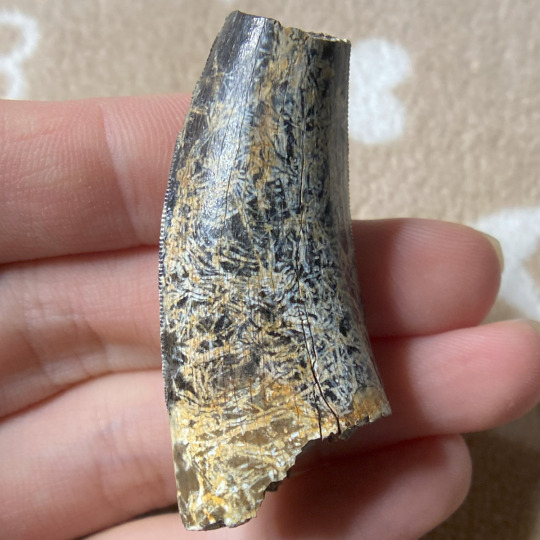
A dinosaur tooth of an Albertosaurus sarcophagus from the Horseshoe Canyon Formation in Drumheller, Alberta, Canada. Contrary to popular belief, this genus is not found in the older Judith River or Two Medicine Formations in the United States. The confusion may have derived from the occasional synonomization of Gorgosaurus into Albertosaurus.
#dinosaur#fossils#paleontology#palaeontology#paleo#palaeo#albertosaurus#tyrannosauridae#albertosaurinae#theropod#cretaceous#mesozoic#prehistoric#science#paleoblr#アルバートサウルス#ティラノサウルス科#恐竜#化石#古生物学
47 notes
·
View notes
Text

Albertosaurus sarcophagus by Frank Lode.
19 notes
·
View notes
Text
Show me a gracile tyrannosaur in a stone coffin, and I’ll show you an Albertosaurus sarcophagus
27 notes
·
View notes
Text
It Came From The Wastebasket #12: Coelurosaur Confusion
Historically Coelurosauria was the counterpart to the Carnosauria, with both of them representing two major lineages of theropod dinosaurs.
Created as a group in the early 20th century, coelurosaurs quickly became a dumping ground for all small-bodied theropods – including coelophysoids, compsognathids, ornithomimids, oviraptorosaurs, dromaeosaurids, and troodontids– and for a while this wastebasket taxon also included the large-bodied ceratosaurids and tyrannosauroids, before they were moved over into the carnosaurs.
But during the 1960s and 1970s this arrangement began to break down. A better understanding of groups like dromaeosaurs revealed a confusing mixture of traditional "carnosaur" and "coelurosaur" anatomical features, and paleontologists struggled to figure out where these sorts of theropods actually fit in.
The development of cladistic methods from the 1970s onwards led to efforts to clean up the coelurosaur wastebasket, trying to figure out a more accurate version of these animals' evolutionary relationships. After briefly collapsing Coelurosauria down to just coelophysoids and "coelurids", the growing recognition of modern birds as living theropod dinosaurs eventually resulted in the group being properly redefined in the 1980s as "birds, and all theropods closer related to them than to carnosaurs".

Clockwise from the left (not to scale): Citipati osmolskae, Albertosaurus sarcophagus, Yi qi, Sinosauropteryx prima
The coelophysoids were finally removed entirely, reclassified as a much earlier branch of theropods – but quite a few of the other groups from earlier concepts of Coelurosauria survived this reshuffling, with the compsognathids, ornithomimids, oviraptorosaurs, dromaeosaurs, and troodontids all proving themselves to have really been closely related the whole time. Meanwhile the tyrannosauroids were brought back in, along with the therizinosaurs, alvarezsauroids, and a whole bunch of paravian and avialan lineages.
(Megaraptorans might belong somewhere in the coelurosaurs, too – possibly being tyrannosauroids – but their classification is currently being disputed.)
———
Nix Illustration | Tumblr | Twitter | Patreon
#it came from the wastebasket#wastebasket taxon#taxonomy#coelurosauria#theropod#dinosaur#paleontology#art#science illustration#paleoart#palaeoblr
237 notes
·
View notes
Text

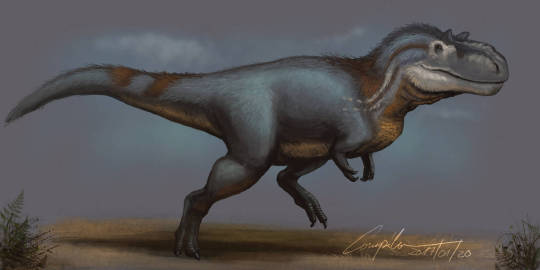



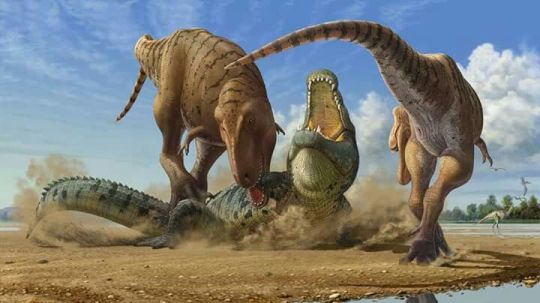



Albertosaurus is a genus of large tyrannosaurid theropod dinosaur that lived in northwestern North America during the early Maastrichtian age of the Late Cretaceous period some 72 to 68 million years ago. The first remains of what is now known as albertosaurus consisted of a partial skull was collected from an outcrop of the Horseshoe Canyon Formation alongside the Red Deer River in Alberta Canada, during a 1884 Geological Survey lead by Joseph Burr Tyrrell. In 1889, Tyrrell's colleague Thomas Chesmer Weston found an incomplete smaller skull associated with some skeletal material at a location nearby. The two skulls were assigned to the preexisting species Laelaps incrassatus by Edward Drinker Cope in 1892. The name albertosaurus wouldn’t be coined until 1905 when Henry Fairfield Osborn published his description of the iconic Tyrannosaurus Rex during which he redescriped the previously mentioned skulls assigning them to there own distinct genus named after the Canadian province established the very same year where the first remains were found. The type species is Albertosaurus sarcophagus hence the creatures full name meaning Flesh eating lizard of Alberta. Since the first discovery in 1884, fossils of more than 30 individuals have been recovered, some of which with intact skin and organs, which provide scientists with a more detailed knowledge of Albertosaurus anatomy than what is available for most other tyrannosaurids. The discovery of 26 individuals in one particular site helped with the research of gregarious behavior, ontogeny and population biology in dinosaurs. Reaching around 26 to 30ft (8-9m) in length and 3,800 to 5,600lbs (1,725 to 2,540kg) in weight, Albertosaurus was a fairly large bipedal predator, but smaller than Tarbosaurus and Tyrannosaurus rex. It sported a more gracile build akin to gorgosaurus sporting small arms, a heavy head and a long muscular tail. Albertosaurus had uniquely long and powerful legs which enabled the animals to comfortably walk at 8 to 13 mph (14- 21 kph). Additionally albertosaurus sported a set of short bony crests above the eyes that may have been brightly coloured in life and possibly used in courtship to attract mates.
Art can be found at the following links:
Albertosaurus Hunting Saurolophus: Frederic Wierum
https://www.artstation.com/artwork/KezreB
Albertosaurus vs Deinosuchus: Vlad Konstantinov
https://www.pinterest.ph/pin/albertosaurus-deinosuchus-by-vlad-konstantinov--567312884302409483/
Albertosaurus: Gabriel Ugueto
https://prehistoric-wiki.fandom.com/wiki/Albertosaurus
Dawn: KookaburraSurvivor
https://www.deviantart.com/kookaburrasurvivor/art/Dawn-732709698
Deinosuchus vs Albertosaurus: Raul Martin
https://www.raulmartin-paleoart.com/deinosuchus-albertosaurus
8 notes
·
View notes
Text
A young Albertosaurus sarcophagus becomes an unfortunate casualty in the aftermath of volcanic activity.

This was an attempt at trying a new artstyle.
#albertosaurus#albertosaurinae#tyrannosauridae#dinosaur#paleoart#digital drawing#digital doodle#cw animal death
4 notes
·
View notes
Text

Can I Help You?
Albertosaurus Sarcophagus
4 notes
·
View notes
Photo

Decided to brush up my initially speed paint drawing of an Albertosaurus, now it looks much nicer. Still not that used to painting rough shapes and then “sculpt” some details into the paint blobs. ^^
#Albertosaurus#albertosaurus sarcophagus#tyrannosauridae#theropoda#dinosaur#cretaceous#sketch#digital art#speedpaint#revisited#myart
87 notes
·
View notes
Photo

Is a genus of tyrannosaurid theropod dinosaurs that lived in western North America during the Late Cretaceous Period, about 70 million years ago. The type species, A. sarcophagus, was apparently restricted in range to the modern-day Canadian province of Alberta, after which the genus is named, although an indeterminate species ("cf. Albertosaurus sp.") has been discovered in the Corral de Enmedio and Packard Formations in Mexico. Scientists disagree on the content of the genus, with some recognizing Gorgosaurus libratus as a second species. As a tyrannosaurid, Albertosaurus was a bipedal predator with tiny, two-fingered hands and a massive head that had dozens of large, sharp teeth. It may have been at the top of the food chain in its local ecosystem. While Albertosaurus was large for a theropod, it was much smaller than its larger and more famous relative Tyrannosaurus rex, growing 9 to 10 m (30 to 33 ft) and possibly weighing 2.5 tonnes (2.8 short tons) or less. Since the first discovery in 1884, fossils of more than 30 individuals have been recovered, providing scientists with a more detailed knowledge of Albertosaurus anatomy than is available for most other tyrannosaurids. The discovery of 26 individuals at one site provides evidence of pack behaviour and allows studies of ontogeny and population biology, which are impossible with lesser-known dinosaurs.
Carnivore
Art (c) reneg661
2 notes
·
View notes
Note
What's your favorite color?
Favorite food?
Hobby?
Anything you like to collect?
Favorite weather?
Favorite time of day?
Favorite dinosaur?
Dream vacation?
Your artistic ability on a scale of 1-10?
Color? Lightning Blue, HEX Code #00DAFF.
Food? Anything with lots if grease. (I'm an American, ya can't blame me)
Hobby? Oh, either playing video games, writing, or making art.
Collecting? Oh yes! Rocks, primarily... but I want to start collecting high-quality toy lightsabers. Oh, and Pokémon in the main games. Gotta Catch 'em All!
Weather? Cold, but not snow-cold. I absolutely hate summertime.
Time of Day? Latenight. It's the only time I can have entirely to myself.
Dinosaur? If we're including Jurassic World Hybrids, then it's a three-way tie between Indominus rex, Albertosaurus sarcophagus, and Majungasaurus crenatissimiss. If not, then exclude the I. rex.
Dream Vacation? Alaska. (I'd actually like to live there, not gonna lie).
Artistic Ability? For professional reasons, I have to say 8. (If I wasn't trying to make money off my art, I'd say 2.) Also, I'd recommend following my art blog, @aldawns-art
Thank you, anon! I don't get asks often, so I really appreciate this!
2 notes
·
View notes
Photo




Albertosaurus Sarcophagus done to a contest called albertoaugust in instagram.
My first time sculpting in Zbrush, texturing in Substance Painter and rendering in Blender Eevee! Loads of new information packed in just a few weeks.
My initial though was to make a little environment for her, but the time just ran out and I didn't have any ready made assets (that would be one of the next projects).
Critique is greatly appreciated!
More pictures in my Artstation !
#dinosaur#palaeoblr#palaeoart#albertosaurus#3d#3d model#paleoart#paleoblr#3d dinosaurus#zbrush#substance painter#blender#blender eevee#kaigonathus#student
146 notes
·
View notes
Text
An Analysis of the Creature Designs in Jurassic Fight Club
The 2008 History Channel miniseries Jurassic Fight Club was not a good show. Almost objectively, it was a badly-done series. The effects were of generally high quality, but those decent effects were in service of a poorly-scripted, gratuitously-violent, scientifically-inaccurate gorefest masquerading as a documentary.
It’s not worth your time.
That said, one bit of unambiguous praise I can give it lies in the designs for the dinosaurs. While they are frequently very inaccurate, they are completely unlike any dinosaur designs in any other media. The showrunners very easily could have just appropriated stock footage from older programs to pad their runtime, but they created unique clips featuring their own designs, which is commendable.
In this post, I’m going to be going through all of the creature designs that appear in Jurassic Fight Club and give my honest thoughts on them. I will factor in both accuracy to the real animal and my own personal tastes, and ultimately assign each one a score out of 10.
So, without further ado, let’s begin:

Majungasaurus crenatissimus (male)
Let’s cover these in order of appearance, which means that the male Majungasaurus is first on the plate. (I am choosing to ignore that they call it Majungatholus in the narration; that is not what this creature’s name is.)
This is a pretty interesting portrayal of this animal. They very easily could have just thrown some skin over the bones and called it a day. But, they stretched their creativity a bit and gave it some speculative soft tissue, and I like that.
That said, the anatomy is completely wrong for a Majungasaurus. The skull is correct, but the arms are too well-developed, and the legs are way too long and lean. Those proportions would work pretty well if this were a Carnotaurus, but it’s a bit too athletic for a majungasaur.
7/10.

Majungasaurus crenatissimus (female)
This is much more in line with what I was expecting from their Majungasaurus. It has the exact same problems as the male, and is missing the speculative soft tissue that I liked so much. Still okay, but not as interesting as the male.
6/10.

Tyrannosaurus rex
No, I don’t know why it’s squatting like that in this promotional image.
Ignoring the weird pose, this isn’t too bad, actually. Sure, it still has broken wrists, and the skull is a bit off, but it otherwise looks about right. For a depiction of T. rex from 2008, this is pretty decent stuff. I like the muted purple color, and I am immensely appreciative of the fact that they didn’t just copy-paste a Jurassic Park rex into their show. They could have very easily done that, but they chose to make something more representative of the actual animal.
8/10.

Nanotyrannus lancensis
This one’s a bit tough to judge. You see, Nanotyrannus doesn’t actually exist. In 2008, it was considered its own genus. But, in the decade since this series aired, it has been all but confirmed that Nanotyrannus is just a juvenile Tyrannosaurus.
That said, as a juvenile Tyrannosaurus, this is pretty good. It’s slim and fierce, with a good color scheme and decent accuracy to the fossils. Aside from the fact that this animal never existed, this is decent. Not bad at all.
7/10.

Deinonychus antirrhopus
I am of completely mixed opinions about this one. On the one hand, aside from the broken wrists, the anatomy is pretty much spot-on. You can tell that the designers actually looked at real Deinonychus skeletons to model this. Also, the blue body with the striping on the tail is a very striking color pallete. As a design, this is actually pretty good.
But, then we get to the elephant in the room. Not a single feather to be found anywhere on its body. Even in 2008, no feathers at all was barely acceptable, and it is completely unforgiveable today.
I have heard that they didn’t do feathers because of budgetary restrictions, which is understandable, but it does drag this design down quite a bit.
I’m going to have to give it a neutral score. It’s a great monster design, but it’s a terrible raptor.
5/10.
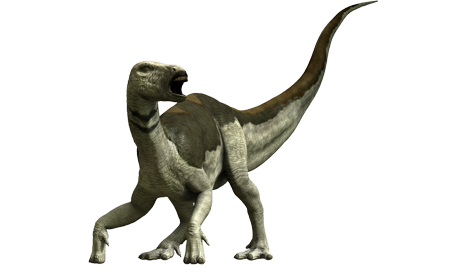
Tenontosaurus tilletti
Poor Tenontosaurus. It pretty much only ever gets media representation so that it can be killed by either Deinonychus or Acrocanthosaurus, and nobody ever seems to give it the time of day.
Fortunate, then, that this is a fantastic design.
Anatomically, it’s spot-on. The colors are dull, but not boring. It has a good amount of soft tissue, and carries a real sense of weight. Out of all the dinosaurs in the show, this one looks the most like a real animal. I have absolutely no complaints.
10/10.

Stegosaurus ungulatus
This is top-quality stuff right here. The proportions are good, even if the tail is a bit on the short side. The hands have the correct number of digits, and all of the plates and spikes seem to be in order. Again, the colors are a bit drab, but it feels appropriate for an animal of this size.
Also, how strange is it that, of all shows, Jurassic Fight Club is the only one I’ve seen that gets Stegosaurus’s weirdly long neck right?
Another triumph.
10/10.

Ceratosaurus nasicornis
Wow.
This is almost entirely perfect.
It has the right skull, it has the long teeth, it has the osteoderms on the back, the proportions are correct. Literally the only inaccuracy I can find is the pronated wrists, but that’s hardly enough to tarnish this thing’s otherwise perfect score.
This may be the best depiction of Ceratosaurus I’ve ever seen, and it is unquestionably the best design in the show.
10/10.

Camarasaurus supremus
Eh.
It looks about right, but it just feels...plain. This is the first one where the dull color scheme is a downside. It’s just flat grey with a yellow head. I do like that detail, but that’s pretty much all it has going for it.
Also, it has elephant feet, which is just wrong.
4/10.
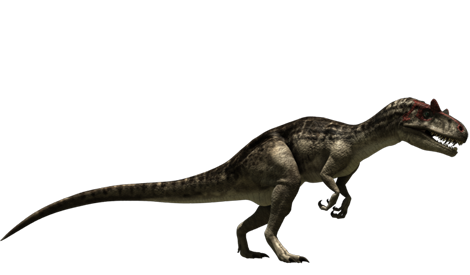
Allosaurus fragilis
Alright, buckle down, because this one’s really bad.
Whereas everything up to this point at least feels like they looked at the actual animal as they were rendering, I’m not certain anyone involved in this thing’s design process had ever seen an Allosaurus skeleton. Let me count the issues:
The skull is so utterly wrong I’m unconvinced they didn’t just completely make it up.
The horns are the wrong size, the wrong shape, and in the wrong spot.
The wrists are broken and stuck on the end of way-too-long human arms.
The torso is too shallow, and has this weird hunchback thing going on.
The legs are too short, and those dainty little feet are bordering on comical. It doesn’t look like it should be able to stand up.
Literally no component of this thing’s anatomy resembles the animal it is supposed to be. It’s a trainwreck.
1/10.

Carcharocles megalodon
To begin with, yes, I am all aboard Team Carcharocles.
With that out of the way, this is a very “meh” design. It’s literally just a big great white shark. No real creativity or imagination at play here. Normally, that would be fine, but C. megalodon isn’t particularly closely related to the great white, so I can’t rate this too highly.
4/10.
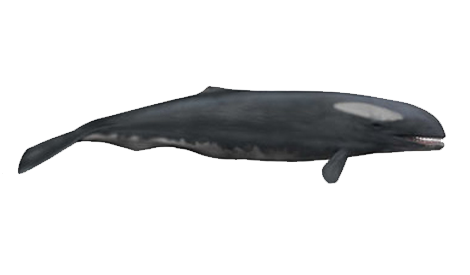
Brygmophyseter shigensis
Conversely, I think that making Brygmophyseter a modified sperm whale is completely appropriate. This animal was a close cousin of the modern sperm whale, and thus would probably look fairly similar.
Decent colors, realistic anatomy, appropriate role within the episode’s story. Pretty decent stuff.
7/10.
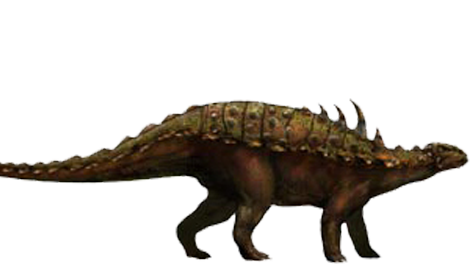
Gastonia burgei
The show’s designers keep doing a really good job with their armored dinosaurs. The Stegosaurus above was one of their best, and Gastonia here is no different.
It certainly helps that Gastonia is known from pretty solid remains, so they had a lot of material to work with. It looks pretty much as it should, and the color scheme is vibrant, but not overdone. Pretty stellar work overall.
9/10.
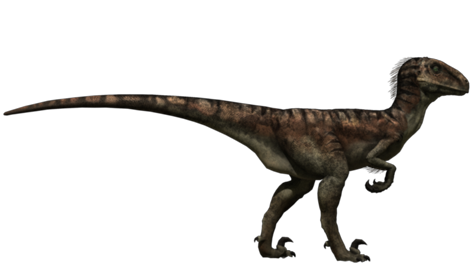
Utahraptor ostrommaysi
Okay, I was willing to be forgiving of the Deinonychus because of the colors, plus the fact that they nailed its skeletal anatomy. This thing doesn’t have either of those advantages.
I can forgive the incorrect skull, Utahraptor‘s skull wasn’t known until nearly a decade after the show came out. What I cannot forgive is the drab, boring color scheme and those AWFUL feathers. If this is all they were going to do to add feathers to their raptors, I’m almost glad they left Deinonychus scaly.
Just awful.
2/10.

Arctodus simus
Wait. They didn’t have the budget to render raptors with proper feathers, but they did have the budget to do an episode all about furry Pleistocene mammals?
Anyways, this is alright. The skull looks a bit off to me, and the legs are too short, but it’s not awful. Y’know, aside from the fact that they gave this bear human eyes for some reason.
6/10.
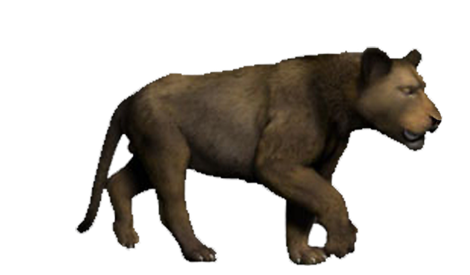
Panthera leo atrox
That sure is a lion.
5/10.

Pachyrhinosaurus canadensis
That is not Pachyrhinosaurus. Even ignoring the erroneous horn, -- which is addressed as speculative within the show -- that is straight-up not the skull of a Pachyrhinosaurus. They just modelled an (admittedly okay-looking) Achelousaurus, and then had the narrator call it Pachyrhinosaurus.
3/10.

Albertosaurus sarcophagus
I don’t even know what to say here. All of the show’s other theropods had something interesting or noteworthy about them, either good or bad. But, this is just every pop-culture Albertosaurus I’ve ever seen.
It certainly is there.
4/10.

Edmontosaurus annectens
This is one of the most completely unremarkable creature designs I’ve ever seen in my life. It’s a single dull color, it has no speculative soft tissue, and its only role in the episode is to be killed and eaten by predators.
This is the closest thing I’ve ever seen to a representation of a Perfectly Normal Beast. There is not a single remarkable thing here.
And it’s a shame, because Edmontosaurus is a very interesting and underrated animal, but here it gets saddled with this halfhearted shrug of a design.
4/10.

Dromaeosaurus albertensis
Yeesh.
This has the advantage of being more anatomically accurate than the Utahraptor and the colors are okay, but those feathers are, again, absolutely appalling.
Topping that off, the narration talks about them communicating with each other via sign language, which is just...dumb. Even as a kid, I thought that was dumb.
2/10.
7 notes
·
View notes
Text
Atrociraptor marshalli

By José Carlos Cortés
Etymology: Savage Thief
First Described By: Currie & Varricchio, 2004
Classification: Dinosauromorpha, Dinosauriformes, Dracohors, Dinosauria, Saurischia, Eusaurischia, Theropoda, Neotheropoda, Averostra, Tetanurae, Orionides, Avetheropoda, Coelurosauria, Tyrannoraptora, Maniraptoromorpha, Maniraptoriformes, Maniraptora, Pennaraptora, Paraves, Eumaniraptora, Dromaeosauridae, Eudromaeosauria
Status: Extinct
Time and Place: About 68.5 million years ago, in the Maastrichtian age of the Late Cretaceous


Atrociraptor is known from Unit 4 of the Horseshoe Canyon Formation, in Alberta, Canada

Physical Description: Atrociraptor was a fairly standard Dromaeosaur - a medium sized theropod, unfortunately there’s not much to be said about its body shape because only parts of the head have been preserved. That being said, it seemed to have a weirdly short and tall skull compared to other raptors. It had straight, but angled, teeth that formed a sort of rake structure within the mouth, with extremely large serrations. This probably would have had a major effect on how it grabbed prey. It probably was roughly the same size as Velociraptor, reaching about two meters long and around one meter tall, though it was potentially closely related to either Saurornitholestes or Deinonychus, and as such may have resembled them more than other dromaeosaurs.
Diet: As a Dromaeosaur, Atrociraptor would have primarily fed upon meat, especially as a predatory animal. As a medium to small sized predatory dinosaur, it would have stuck to smaller animals such as lizards and mammals, and only ventured to eat larger sources of food when the opportunity was good (such as when mob hunting or when the prey was sick or wounded.

By Calum O’Halloran
Behavior: Like other raptors, Atrociraptor would probably have been mainly a solitary predator, stalking its prey and using ambush to attack - rather than pursuit. Though, of course, without preserved legs this is mainly a hypothesis based on its relatives. It would have used kicking and jumping to catch its prey by surprise, and used two specialized behaviors to hunt its prey: raptor prey restraint, where it flapped its wings very fast in order to stay balanced on top of struggling prey; and wing-assisted incline running, in which it flapped its wings hard to run up steep surfaces such as cliffs and trees - in order to chase food. If it lived in groups, it would have probably just been small families; and Atrociraptor probably took care of its young.
Ecosystem: Atrociraptor is from the Horseshoe Canyon Formation, a late Cretaceous environment from Alberta, Canada. It was a fairly warm, arid environment, with consistently shifting terrain and features. Somewhat removed from the inland sea, it wasn’t associated with the coast like other late Cretaceous ecosystems (such as Hell Creek), and thus featured major differences in flora and fauna compared to these landscapes (for example, there was a surprising lack of turtles). As such, it was marked by small wet seasons, followed with very long dry seasons. All the water would drain from the land during these times, creating a vast scrubland. This was an environment dominated by ferns and more arid-adapted horsetails, though some conifers were present, along with flowering plants.

By Michael B. H., CC BY-SA 3.0
Many types of dinosaurs lived with Atrociraptor, including the ankylosaur Anodontosaurus, the small bipedal herbivore Parksosaurus, the hadrosaurs Hypacrosaurus and Saurolophus, a Leptoceratopsid of some sort, the tyrannosaurs Daspletosaurus and especially Albertosaurus, the ostrich mimic Struthiomimus, and the alvarezsaur Albertonykus. Weirdly enough, there were no large Ceratopsians in this environment, reflecting a gap in Ceratopsian evolution between the extreme diversity in the Campanian and the drop at the end of the Maastrichtian. There were also other reptiles, such as the Choristodere Champsosaurus.
Other: Atrociraptor has been heavily associated with Albertosaurus, though what that relationship might have been (if any) is uncertain.
~ By Meig Dickson
Sources under the Cut
Arbour, V. (2010). "A Cretaceous armoury: Multiple ankylosaurid taxa in the Late Cretaceous of Alberta, Canada and Montana, USA". Journal of Vertebrate Paleontology. 30 (Supplement 2): 55A.
Currie, P. J. and D. J. Varricchio (2004). "A new dromaeosaurid from the Horseshoe Canyon Formation (Upper Cretaceous) of Alberta, Canada". Pp. 112–132 in P. J. Currie, E. B. Koppelhus, M. A. Shugar and J. L. Wright. (eds.), Feathered Dragons. Indianapolis: Indiana University Press.
Larson, D. W., Brinkman, D. B., & Bell, P. R. (2010). Faunal assemblages from the upper Horseshoe Canyon Formation, an early Maastrichtian cool-climate assemblage from Alberta, with special reference to the Albertosaurus sarcophagus bonebed This article is one of a series of papers published in this Special Issue on the theme Albertosaurus. Canadian Journal of Earth Sciences, 47(9), 1159-1181.
Longrich, N. R., and P.J. Currie, 2009, "A microraptorine (Dinosauria-Dromaeosauridae) from the Late Cretaceous of North America". Proceedings of the National Academy of Sciences 106: 5002-5007
Quinney, A; Therrien, F.; Zelenitsky, D. K.; Eberth, D. A. (2013). "Palaeoenvironmental and palaeoclimatic reconstruction of the Upper Cretaceous (late Campanian–early Maastrichtian) Horseshoe Canyon Formation, Alberta, Canada". Palaeogeography, Palaeoclimatology, Palaeoecology. 371: 26–44.
Ryan, M. J., P. J. Currie, et al. (1998). "Baby hadrosaurid material associated with an unusually high abundance of Troodon teeth from the Horseshoe Canyon Formation, Upper Cretaceous, Alberta, Canada". Gaia 16: 123–133
#Atrociraptor#Atrociraptor marshalli#raptor#dinosaur#Dromaeosaur#bird#feathered dinosaurs#birds#dinosaurs#Cretaceous#North America#Carnivore#Theropod Thursday#prehistoric life#paleontology#prehistory#palaeoblr#birblr#factfile#biology#a dinosaur a day#a-dinosaur-a-day#dinosaur of the day#dinosaur-of-the-day#science#nature
170 notes
·
View notes
Photo

Name: Alberta lizard
Scientific Name: Albertosaurus sarcophagus
Diet: Carnivore
Date: Late Cretaceous (71 to 68 mya)
Size: 9 m (30 ft) long
Weight: Between 1.3 tonnes and 2.5 tonnes (2.8 tons)
Location: Western North America
Additional Information: Since 1984, over 30 individuals have been recovered, providing scientists detailed knowledge of Albertosaurus.
Image source: https://www.reddit.com/r/jurassicworldevo/comments/bw8v9e/albertosaurus_claires_sanctuary_dlc/
#extinctanimaloftheday #extinctanimal #prehistory #prehistoric #extinct #albertosaurus #alberta #tyrannosaur #jurassicworld #jurassicworldevolution
0 notes